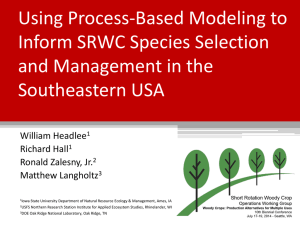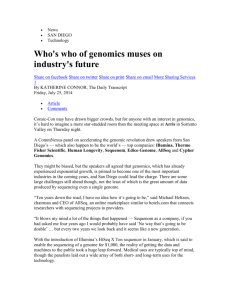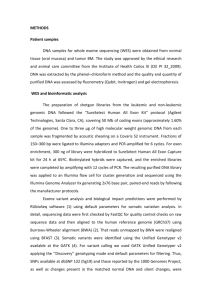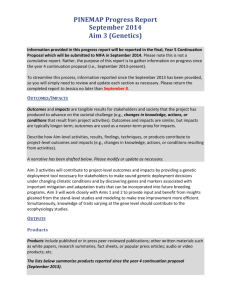Aim 3 Year 2 Interim Report application/vnd
advertisement
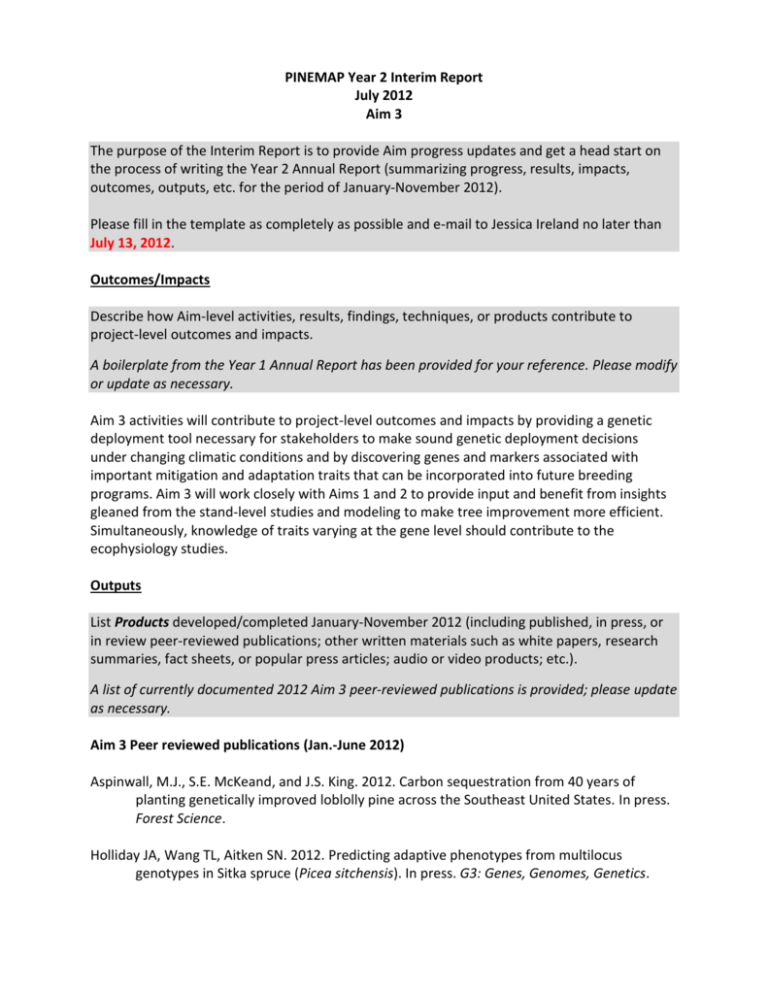
PINEMAP Year 2 Interim Report July 2012 Aim 3 The purpose of the Interim Report is to provide Aim progress updates and get a head start on the process of writing the Year 2 Annual Report (summarizing progress, results, impacts, outcomes, outputs, etc. for the period of January-November 2012). Please fill in the template as completely as possible and e-mail to Jessica Ireland no later than July 13, 2012. Outcomes/Impacts Describe how Aim-level activities, results, findings, techniques, or products contribute to project-level outcomes and impacts. A boilerplate from the Year 1 Annual Report has been provided for your reference. Please modify or update as necessary. Aim 3 activities will contribute to project-level outcomes and impacts by providing a genetic deployment tool necessary for stakeholders to make sound genetic deployment decisions under changing climatic conditions and by discovering genes and markers associated with important mitigation and adaptation traits that can be incorporated into future breeding programs. Aim 3 will work closely with Aims 1 and 2 to provide input and benefit from insights gleaned from the stand-level studies and modeling to make tree improvement more efficient. Simultaneously, knowledge of traits varying at the gene level should contribute to the ecophysiology studies. Outputs List Products developed/completed January-November 2012 (including published, in press, or in review peer-reviewed publications; other written materials such as white papers, research summaries, fact sheets, or popular press articles; audio or video products; etc.). A list of currently documented 2012 Aim 3 peer-reviewed publications is provided; please update as necessary. Aim 3 Peer reviewed publications (Jan.-June 2012) Aspinwall, M.J., S.E. McKeand, and J.S. King. 2012. Carbon sequestration from 40 years of planting genetically improved loblolly pine across the Southeast United States. In press. Forest Science. Holliday JA, Wang TL, Aitken SN. 2012. Predicting adaptive phenotypes from multilocus genotypes in Sitka spruce (Picea sitchensis). In press. G3: Genes, Genomes, Genetics. Summarize Events/Activities (January 2012-current) as follows: Provide a bulleted list of presentations (oral and poster) given at meetings or conferences. The format for citing presentations is as follows: Presenter(s)/Author(s). Date. Name/title of meeting/conference, location. Bawa R. and J. Holliday. July 6-12, 2012. Signatures of natural selection and local adaptation in Populus trichocarpa and Populus deltoides along latitudinal clines. Joint Congress on Evolutionary Biology. Ottawa, Ontario, Canada. Chhatre, V. May 22-23, 2012. Evolutionary and population genetics of the Lost Pines: Lessons from history. Western Gulf Forest Tree Improvement Contact Meeting, Bastrop, TX Holliday, J.A. and L. Zhou. July 7-11, 2012. Toward whole-genome association mapping and landscape genomics in trees. Botany 2012 – The Next Generation (Annual Meeting of the Botanical Society of America). Columbus, OH, USA. Krutovsky, K. May 22-23. How genomics can help restore the Lost Pines. Western Gulf Forest Tree Improvement Contact Meeting, Bastrop, TX Farjat, A. May 10. Climate variables and height growth in the Plantation Selection Seed Source Study field trials. NC State University Cooperative Tree Improvement Program Advisory Board Meeting, Raleigh, NC. Whetten, R. May 10. Preliminary results from Genotyping-By-Sequencing experiments in loblolly pine. NC State University Cooperative Tree Improvement Program Advisory Board Meeting, Raleigh, NC. Provide a short narrative describing any workshops, courses, and/or trainings conducted. Fikret Isik of the NC State University Cooperative Tree Improvement Program co-taught a week-long workshop entitled “Genetic Data Analysis: Applications in Plant and Animal Breeding” at the Czech University of Life Sciences in Prague, Czech Republic, June 11 – 15, 2012. The course covered statistical methods for analysis of field trials, including methods appropriate for trials planted at multiple sites to estimate impacts of climate variation on forest productivity. The course was jointly organized by NC State University Forestry Education and Outreach Program and forestry faculty from the Czech University of Life Sciences. Provide a short narrative describing experiments or surveys conducted and/or analyzed. Will Kohlway (undergraduate research intern) and Laura Townsend (a new MS student), working under the supervision of Ross Whetten at NC State University, prepared samples for genotyping-by-sequencing of 90 progeny and two parent trees, and submitted the samples to a sequencing service provider for analysis. Results are expected by early August. PINEMAP Interim Report, July 2012, Aim 3 2 Milestones and Work Plan Progress All year 2 milestones and work plan tasks have been listed below. Provide a short narrative describing progress on each; if work on milestone or task has not yet begun, leave blank. Milestones Version 1 of genetic deployment tool with provenance information. 1) Texas A&M: Develop a Uniform Response Function based on analysis of 73 tests of the WGFTIP Seed Source Study of 43 selected families (divided into two series). Initial analysis is focused on using 1) minimum winter temperatures and 2) summer heat/moisture index as dependent variables and height growth as the independent variable. All raw progeny test data from this study has been supplied to University of Florida for the Tier 1 database. 2) NC State University: Retrieve climate data for 19 field test sites of the Plantation Selection Seed Source Study for analysis with height growth data, to create a Uniform Response Function for the NC CTIP germplasm base. The growth data from these sites have also been provided for the Tier 1 database. Determine appropriate genome reduction methods for genotyping by sequencing. 1) Texas A&M: Agilent’s SureSelect Target Enrichment System was used to select exon regions in loblolly pine. 647,634 baits were designed using 35,550 unigenes and the Agilent’s eArray software. The total capture library size was approximately 78MB. Subsequently, genomic DNA of a haploid megagametophyte and a diploid embryo from the same seed from the reference tree 20-1010 were isolated. After fragmenting the total genomic DNA into 150 to 200 bp long fragments, two sequencing libraries were built, one from each source of genomic DNA, and then hybridized with the capture library. After hybridization, the captured DNA was isolated using magnetic beads and amplified with index primers. The amplified selected sequences are currently being sequenced using Hiseq 2000 sequencer. 2) NC State University: A published procedure for Genotyping-By-Sequencing using two restriction enzymes to fragment genomic DNA (Poland et al, PLoS One 7: e32253, 2012) was used to prepare DNA samples from two parents and 90 progeny of loblolly pine. The samples were submitted to a sequencing service provider, and results are expected by August. A tissue storage solution has been developed and tested that allows collection of tissue samples in the field and storage at ambient temperature for days to weeks before DNA extraction, with good preservation of DNA quality. 3) Virginia Tech: Genome complexity reduction by the ‘RAD-seq’ approach was completed for 10 haploid megagametophyte and two diploid needle samples, and the libraries are awaiting sequencing on an Illumina Hi-Seq instrument. Results are expected from the sequencing center in a few weeks. PINEMAP Interim Report, July 2012, Aim 3 3 Work Plan Tasks Obtain appropriate weather data for each of the entries in the progeny test database. 1) Texas A&M: Provisional weather data were downloaded from NOAA National Climatic Data Center (http://www.ncdc.noaa.gov/cdo-web/search). 2) NC State University: In collaboration with the TerraC database staff, GIS coordinates for test sites and county-level regions of interest have been defined and climate data recovered from the PRISM dataset for a subset of the locations of interest. Additional PRISM data will be retrieved over the coming weeks to provide the complete dataset for future analyses; additional data retrievals will be made as alternate datasets become available. Agree to standardized traits for analysis and a methodology for stratifying locations. Develop mixed model analysis for URF. Analyses in progress; initially focusing on using 1) minimum winter temperatures and 2) summer heat/moisture index as dependent variables and height growth as the independent variable. Continue Phenotyping for: insect and disease resistance; response to fertilizer; insect and disease resistance Measurements of growth in field tests are typically taken in the fall and winter, during the dormant season. Reduction of Genome Complexity for generating molecular markers. 1. Test of genotyping-by-sequencing protocol and data analysis pipeline reported by Elshire et al., PLOS One 6(5): e19379, 2011 2. SureSelect 3. DaRT libraries 4. RAD-seq libraries Compare methods for: 1. Cost per sample 2. Recovery of polymorphic SNPs 3. Ability to distinguish paralogous variants from allelic variants 4. Suitability for high-throughput sequencing Reduction of genome complexity for generating molecular markers/gene discovery. 1) Texas A&M: a. Sequence data captured through the SureSelect enrichment process will become available in mid-July. The procedure will be evaluated for effectiveness and efficiency and metrics tabulated for comparison to other techniques under PINEMAP Interim Report, July 2012, Aim 3 4 development by the group. The sequences will be assembled into contigs and mapped to the unigenes, then SNP discoveries will be conducted. We will try to identify alleles in adaptive trait related genes that could be involved in response to climate change via association mapping. b. Foliage samples will be collected from the ADEPT II population located at the Harrison Experimental Forest, Southern Institute of Forest Genetics. DNA extraction will begin as time allows. This is to support gene discovery through the analysis of the geographical distribution of alleles. 2) Virginia Tech: Results from the RAD-seq libraries will be available by August, at which time we will align them to the reference genome and assess various parameters such as depth of coverage, coverage heterogeneity, missing data, etc. These data will be integrated with those from other genetics aim group to determine the relative merits and drawbacks of each technique, and to identify one or more that will be used in the various trials to be genotyped across the southeast. 3) NC State University: The protocol reported by Elshire et al was tested with loblolly pine samples in a preliminary experiment conducted by Will Kohlway and Ross Whetten between January and March 2012. The analytical software of Elshire et al was used to analyze the preliminary data, and results of this analysis were presented at the PINEMAP annual meeting and reported to stakeholders at the Advisory Board Meeting of the NC State Cooperative Tree Improvement Program. The reproducibility of genotyping the same loci in multiple individuals was too low in this preliminary experiment to provide confidence in the technique. A second trial was conducted using the modified protocol reported by Poland et al, and those samples are still at the sequencing service provider. Results are expected within the next few weeks. Data analysis of those results will use both the software described by Elshire et al, and new software described by Peterson et al (PLoS One 7:e37135, 2012), which is reported to have some advantages. Identified genetic loci will be compared to the draft loblolly pine reference genome assembly produced by the PineRefSeq genome sequencing project to determine the extent to which the GBS marker loci are located in or near genes identified by the genome sequencing project. Annual Report Sidebars We will highlight interesting results, stories, or successes for each Aim in sidebars in the annual report. Please identify at least two items from your Aim that will become sidebars for the annual report. Each sidebar should be illustrated with a figure, table, or photograph that will draw attention. In addition, provide a paragraph of text summarizing the experiment, project, or result. PINEMAP Interim Report, July 2012, Aim 3 5 Genetic Analysis of Growth Response to Climate Variables in Loblolly Pine The Plantation Selection Seed Source Study (PSSSS) field trials were established by members of the NC State University Cooperative Tree Improvement Program during the 1990s, to evaluate how seeds from loblolly pine trees from different regions of the southeastern US would respond to being planted in different parts of the southeast. The upper map shows the locations of 22 field test sites (red dots) across 7 states, along with locations of local weather stations around the region (black dots). The middle map shows the county of origin of loblolly pine trees from which seeds were collected to be planted at those 22 test sites, and the bottom map shows the average minimum temperature for the 12 years between the time the first field trials were planted and the final measurements were taken. Of course, other climate factors will affect how trees from (for example) Maryland will grow in a test site in (for example) southern Mississippi, or vice versa. Soil types, nutrient levels, and other variation in site quality or growing conditions will also affect the growth of trees, but the fact that seedlings from all the parents from across the region were all planted at the same sites, scattered across the region, means that the effect of climate variables will be detectable. Preliminary analyses have already shown that the different parent trees have differing degrees of genetic ‘resilience’, or ability to adapt to climate factors that are different from those at the site where the parent tree grew. New genomic technology, based in part on the availability of a reference genome sequence for loblolly pine, will allow analysis of this genetic variation among parents to identify genes that are associated with resilience, so that breeding programs across the South have the tools they need to breed for trees that can withstand changes in climate. PINEMAP Interim Report, July 2012, Aim 3 6 Broad Impacts & External Collaborations Provide a short narrative describing broad impacts (i.e., far-reaching and possibly unanticipated outcomes resulting from Aim work, including contacts/collaborations with entities outside of PINEMAP). The PineRefSeq CAP funded to obtain reference genome sequences for loblolly pine, sugar pine, and Douglas fir has been generous in releasing a draft loblolly pine genome sequence assembly for use in analysis of genotyping data generated by PINEMAP. PINEMAP researchers will continue to collaborate with the PineRefSeq project team to coordinate storage and analysis of genotype and phenotype data obtained during the PINEMAP project, with the objective of helping to evaluate and improve the reference genome assembly produced by the PineRefSeq project and provide additional genotypic data sampled from a diverse set of loblolly pine genotypes. Contact is continuing between PINEMAP (represented by Ross Whetten, NC State University) and FoResTTraC, a European Union project to develop coordinated research plans to study adaptation of forest trees to climate change. The name is an acronym for “Forest ecosystem genomics Research: supporTing Transatlantic Cooperation”, and the objective is to coordinate activities among North American and European researchers in the fields of ecology, genetics, genomics, and evolution of forest trees. More information about FoResTTraC is available at http://www.foresttrac.eu/. Training Please list undergraduate and graduate students, postdocs, and technical personnel trained under this project and include a description of their research focus and/or role in the project. A list is provided from the Year 1 Annual Report; please update as necessary to cover the time period January-November 2012. Rajesh Bawa, Ph.D. student, Virginia Tech. Rajesh is conducting Phenotyping of adaptive traits (i.e., cold hardiness and bud phenology) in the loblolly pine progeny trials and working with universities across region to conduct genome-wide association mapping between these traits and the re-sequencing data. Alfredo Farjat, Ph.D. student, North Carolina State University. Alfredo is carrying out joint analysis of progeny test data and climate data for the Cooperative Tree Improvement Program. Tomasz Koralewski, Postdoctoral Associate, Texas A&M University. Dr. Koralewski is building a location database for the progeny tests and the parents represented in those progeny tests that can be linked to climatic data. This database will form the backbone of the URF analysis to optimize seedling deployment. Mengmeng Lu, Ph.D. student, Texas A&M University. Mengmeng is evaluating efficiency of Aglient SureSelect target gene enrichment system for Illumina GAII and HiSeq highprobe design using the Agilent eArray tool and the most recent and comprehensive unigene set consisting of 42077 sequences representing individual genes expressed in loblolly pine. PINEMAP Interim Report, July 2012, Aim 3 7 Will Kohlway and Ben Rusche, undergraduate student research interns, North Carolina State University. Will and Ben are working on pilot scale experiments to test genotyping-by-sequencing as a cost-effective means of genotyping the experimental populations. Laura Townsend, M.S. student, North Carolina State University. Laura’s research focus is genetic variation in loblolly pine for adaptability to climate variables. Jianxing Zhang, Ph.D. student, University of Florida. Jianxing is conducting analyses linking progeny test performance with climatic data and developing a database for the URF analysis to optimize seedling deployment. Collaborations and “integrated” knowledge developed Provide a short narrative describing new ideas, research questions, or insights that have arisen through work and discussions with colleagues, stakeholders, and others. In addition, explain the extent to which you intend to incorporate this into PINEMAP milestones and/or your Aim work plan. Needs from/linkages to other Aim groups Provide a bulleted list outlining research results, data, products, or assistance that your Aim group needs from another Aim group. - Aim 1 o Coordination of sampling strategy, so that tissue can be collected from all individuals on which individual-tree measurements of any sort are made during the course of this project, for eventual genotyping. The storage solution developed at NC State allows ambient-temperature storage of foliage or of cambium disks taken from increment-core wood samples for periods of days to weeks, reducing the burden on field crews taking other measurements or samples. - Aim 6 o Information on climate science and future climate scenarios for decision support system module development o Presentation of state of climate science to cooperative members - Aim 4 o Information on regional changes in insect risks o Impact of policy changes on reforestation needs - Aim 5 o Course for graduate students to take on conducting trans-disciplinary research PINEMAP Interim Report, July 2012, Aim 3 8 Provide a bulleted list outlining research results, data, or products that your Aim group has compiled that have value or relevance to another Aim group (and note which Aim group). - AIM 6 o AIM 3 inputs and outputs provided to AIM 6 group (Ryan Boyles and Heather Dinon) as part of the aim interactions analysis for the purpose of Decision Support System (DSS) List any additional potential linkages to other Aim groups. Leveraged funding/additional resources Describe how PINEMAP funds were leveraged as well as any additional resources obtained. Please list amounts and sources. Work planned/progress expected Briefly describe a forecast of Aim work planned and progress expected for June-December 2012. If there are any major changes to the Aim year 2 work plan, please also explain here. Texas A&M: 1) Evaluation of SureSelect should be completed. 2) DNA will be extracted from the ADEPT II population. 3) Version 1 of the URF for the WGFTIP seed source study will be developed. Virginia Tech: 1) Evaluation of RAD-seq should be completed. 2) Phenotyping of loblolly pine trails for adaptive traits, including bud phenology and cold hardiness. NC State University: 1) Evaluation of two-enzyme GBS and comparison of analytical software should be completed. 2) The NC State planting of the ADEPT II population near Macon, GA was adversely affected by drought during the summer of 2011, so analysis of that set of individuals will not be pursued as was originally proposed. An alternate set of clonally-replicated plantings is available from the NC State Cooperative Tree Improvement breeding program, and will be used instead. Tissue samples will be collected from those trees, and from representative trees in field tests of the Plantation Selection Seed Source Study, and DNA extracted and genotyped. 3) Version 1 of the URF for the NCSU – CTIP PSSSS will be developed. PINEMAP Interim Report, July 2012, Aim 3 9 PINEMAP Newsletter The purpose of the PINEMAP newsletter is to highlight and summarize PINEMAP project updates, research results and experiments, outputs such as products/events/activities, etc. The target audience includes the general public, internal PINEMAP collaborators, stakeholders, NIFA, and external partners. The anticipated publication date for the first newsletter is sometime in August or September 2012. Please identify a topic for a brief (300-500 word) article for the first issue of the PINEMAP newsletter. Outline a preliminary article title, provide a brief (3-5 sentence) summary, and list authors. Title: Genotyping by DNA sequencing in conifers: an evaluation of alternative approaches Summary: Several methods for genotyping using high-throughput DNA sequencing have been described using model organisms or annual crops. Application of these techniques to conifers, such as loblolly pine, is not trivial, because the pine genome is several times larger and contains more repetitive DNA than most of the species in which these techniques were developed. As part of the PINEMAP research objectives on genetic analysis of pine populations, we have compared several techniques to evaluate the relative strengths, weaknesses, costs, and benefits of each. No single technique is optimal for every purpose, so the objectives of individual experiments are important in determining which method is best suited to achieve the desired results. Author List: TAMU – Kostya Krutovsky, Mengmeng Lu; NC State – Ross Whetten, Will Kohlway, Laura Townsend; Virginia Tech – Jason Holliday, Rajesh Bawa? + postdoc? PINEMAP Interim Report, July 2012, Aim 3 10


